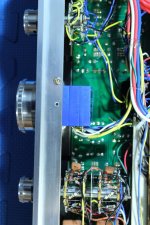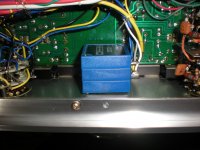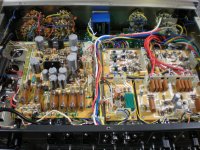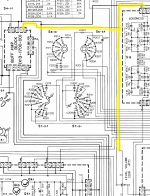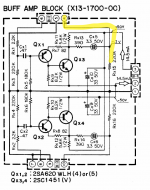This isn't critical, but if I could find a decent/high quality replacement for the volume attenuator in my Kenwood 700c preamp I'd be tempted. It is a 2 gang 20k part with loudness tap.
Are there any available with a loudness tap, or could I add a loudness tap to one?
The original works but needs periodic cleaning. I can deal with that but thought I'd see if anyone here had anything to suggest. This is my main preamp. It is a truly great unit. Many units have crossed my bench but none have beat it and few come close.
Are there any available with a loudness tap, or could I add a loudness tap to one?
The original works but needs periodic cleaning. I can deal with that but thought I'd see if anyone here had anything to suggest. This is my main preamp. It is a truly great unit. Many units have crossed my bench but none have beat it and few come close.
Looks like the Alps RH2702 would work, if you can find one in the value with loudness taps that you want.
There appears to be room for a smaller switched resistor control, which would have a node to connect the
loudness circuit.
There appears to be room for a smaller switched resistor control, which would have a node to connect the
loudness circuit.
Seems finding that Alps part in the right value will be a challenge.
I found these. Closest value they have is 25k. I'm wondering if that will be close enough, or if the circuit can be adjusted to compensate. I have a recent thread here about a McIntosh C26 volume control where we changed a capacitor value so I could use a different value pot.
https://www.goldpt.com/compare.htmlCan a loudness tap be added to any attenuator where I can access the resistors by attaching a wire in the right place?
I don't want to take any shortcuts here, if I swap the volume control on a unit like this it has to be right.
I found these. Closest value they have is 25k. I'm wondering if that will be close enough, or if the circuit can be adjusted to compensate. I have a recent thread here about a McIntosh C26 volume control where we changed a capacitor value so I could use a different value pot.
https://www.goldpt.com/compare.htmlCan a loudness tap be added to any attenuator where I can access the resistors by attaching a wire in the right place?
I don't want to take any shortcuts here, if I swap the volume control on a unit like this it has to be right.
The frequency behavior will change if the pot is 25k instead of 20k.
Goldpoint says they sell blank boards so you can make your own value of control.
These are rather expensive controls, but should work well.
A thin wire would be soldered to a particular node on the array for the loudness tap.
You would determine where by measuring the resistance of the tap on your present control.
Alternatively, it is likely that you could use the 25k control, and scale the Rs and Cs in the loudness circuit (connected to the tap)
in proportion to compensate. That is, increase the Rs by a factor of 25/20 (or 1.25), and decrease the Cs by a factor of 20/25 (or 0.8).
Then all of the time constants would remain the same as in the original circuit.
Goldpoint says they sell blank boards so you can make your own value of control.
These are rather expensive controls, but should work well.
A thin wire would be soldered to a particular node on the array for the loudness tap.
You would determine where by measuring the resistance of the tap on your present control.
Alternatively, it is likely that you could use the 25k control, and scale the Rs and Cs in the loudness circuit (connected to the tap)
in proportion to compensate. That is, increase the Rs by a factor of 25/20 (or 1.25), and decrease the Cs by a factor of 20/25 (or 0.8).
Then all of the time constants would remain the same as in the original circuit.
Last edited:
I'm a pro with through hole soldering but not so much with SMD. Probably because I don't have the right tools for it. So I'd be hesitant to build my own.
I suppose I could ask them if there was any way they could built a 20k pot though that might be even more expensive.
Are there any comparable parts that are cheaper? From what I've seen most are in that range, unless they are from China on ebay.
I suppose I could ask them if there was any way they could built a 20k pot though that might be even more expensive.
Are there any comparable parts that are cheaper? From what I've seen most are in that range, unless they are from China on ebay.
On closer inspection it looks like the blank ones they sell require through hole parts not SMD.
They have a chart showing resistor values for different resistances. But they don't show 20k. I'd just need to double the values for the 10k attenuator, right?
They have a chart showing resistor values for different resistances. But they don't show 20k. I'd just need to double the values for the 10k attenuator, right?
Yes, double all the 10k values. Read their info well before deciding. You may have difficulty buying some resistor values
from some vendors, since stocking hundreds of values per wattage in large quantities is expensive.
from some vendors, since stocking hundreds of values per wattage in large quantities is expensive.
I have plenty of experience sourcing parts through mouser and digikey. So I totally expect putting together a resistor list to be a total PITA especially if I want them to all be the same brand/series.
I'll have to physically measure the part to be sure but I think I can fit it with lots of room to spare.
I'll have to physically measure the part to be sure but I think I can fit it with lots of room to spare.
Here's another place with different options.
https://www.hificollective.co.uk/index.php/components/stepped_attenuators.html
https://www.hificollective.co.uk/index.php/components/stepped_attenuators.html
Odds are that no one will have even half of the values you will need, in the right wattage and brand/type.I have plenty of experience sourcing parts through mouser and digikey. So I totally expect putting together a resistor list to be a total PITA especially if I want them to all be the same brand/series.
Well this is significantly cheaper, and they have it in 20k.Here's another place with different options.
https://www.hificollective.co.uk/index.php/components/stepped_attenuators.html
https://www.hificollective.co.uk/in...tenuator-025w-metal-film-resistor-p-9286.htmlI suppose I hit the wall of diminishing returns fairly early on even though this is a high end unit because there are other old switches in it, and most of the resistors are carbon film.
What I need most is for it to be reliable long term, and for both channels to be very well matched.
I'm confused about what option I'd want for "attenuator type" for that one I linked above.
Is shunt type what I want?
Is shunt type what I want?
Okay I think I understand the choices. They are just what quality of switch it is. And how many steps.
A bit cheaper than the goldpoint but not by a massive amount if I get a midrange option.
A bit cheaper than the goldpoint but not by a massive amount if I get a midrange option.
I'd need a series attenuator as opposed to a shunt attenuator to be able to add a loudness tap, am I correct?
The goldpoint attenuators are series type but there don't appear to be cheaper series alternatives from the other source.
The goldpoint attenuators are series type but there don't appear to be cheaper series alternatives from the other source.
Last edited:
Yes, correct. To have a loudness tap, the attenuator must be of the series type, which is just a string of many resistors in series.I'd need a series attenuator as opposed to a shunt attenuator to be able to add a loudness tap, am I correct?
The goldpoint attenuators are series type but there don't appear to be cheaper series alternatives from the other source.
Hi-Fi Collective does have some series attenuators.
https://www.hificollective.co.uk/catalog/elma-a47-series-smd-stepped-stereo.htmlhttps://www.hificollective.co.uk/catalog/khozmo-stereo-series-stepped-attenuator-step-25k.html
Here is another type of series attenuator made by DACT, also expensive..
http://www.dact.com/html/attenuators.html
The shunt type is only two resistors used at a time (series and shunt), usually with the shunt resistor being varied to change the attenuation.
Sometimes both resistors of the shunt attenuator are changed at the same time (ladder attenuator), so the input impedance is constant.
Last edited:
Since those are all more expensive than the goldpoint, it still seems like the best option. At a certain point, I'd have to redo the entire system with top quality resistors, silver solder, $1k worth of audio caps, and some space shuttle grade copper wire for things to actually make a difference.
Next, I'm wondering how easy the mod would be if I were to make a different value control work. Which resistors/capacitors do I have to scale?
Here's a couple snapshots of the schematic showing the signal paths leading to the input of the volume control.
Then I can decide if it is easier to make a different value part work, or build a 20k goldpoint part myself.
Next, I'm wondering how easy the mod would be if I were to make a different value control work. Which resistors/capacitors do I have to scale?
Here's a couple snapshots of the schematic showing the signal paths leading to the input of the volume control.
Then I can decide if it is easier to make a different value part work, or build a 20k goldpoint part myself.
Attachments
- Home
- Design & Build
- Parts
- 20k Stepped Attenuator with loudness tap?
